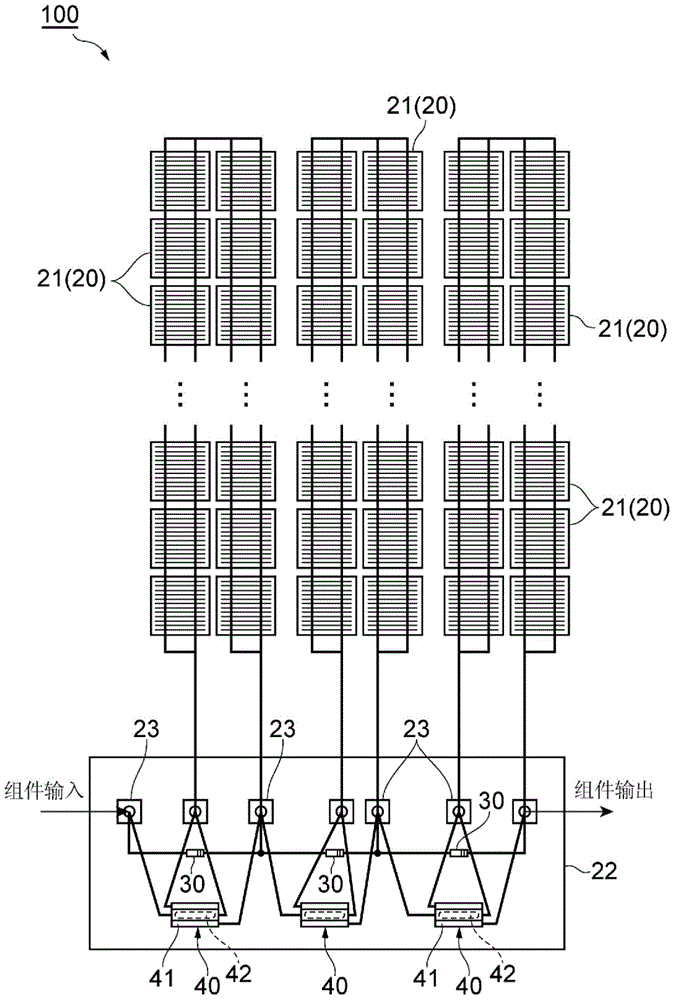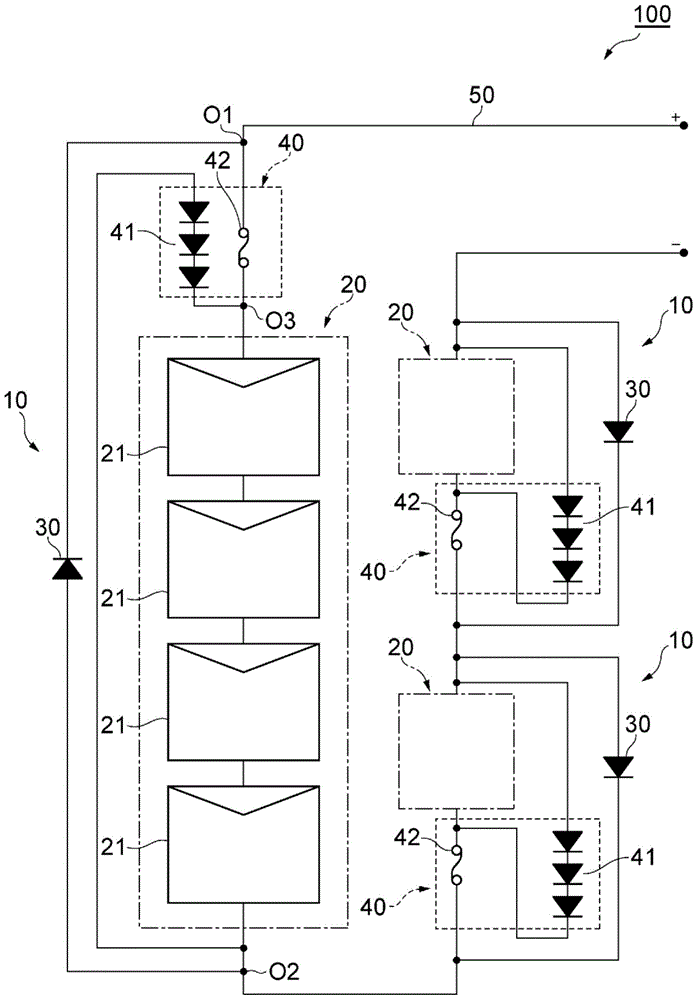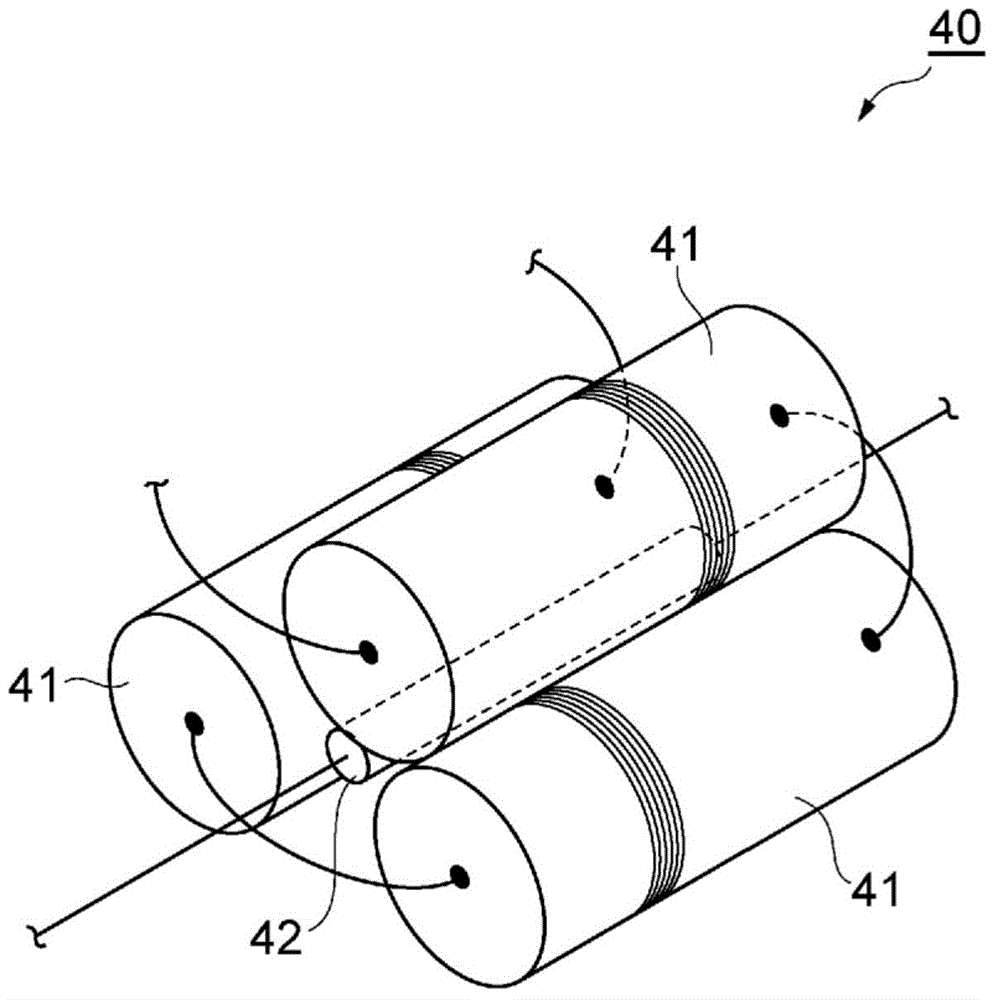Solar cell unit and solar cell module
A technology of solar cells and components, applied in electrical components, circuits, photovoltaic power generation, etc., can solve problems such as unsuitable safety and cost, daily inspection, complicated operations, etc., and achieve the effects of ensuring power generation capacity, improving reliability, and suppressing damage
- Summary
- Abstract
- Description
- Claims
- Application Information
AI Technical Summary
Problems solved by technology
Method used
Image
Examples
no. 1 approach
[0035] The first embodiment will be described. figure 1 is a configuration diagram showing the solar cell module according to the first embodiment, figure 2 yes figure 1 A schematic circuit diagram of a solar module, image 3 It is a perspective view showing an element complex. Such as figure 1 , 2 As shown, a plurality of solar cell modules 100 of this embodiment are installed in series on a high place such as a roof, for example, to constitute a system-cooperative photovoltaic power generation system having an output voltage of 200V or higher. The solar cell module 100 includes a plurality of (here, three) solar cell cells 10 connected in series.
[0036]Each of the plurality of solar cells 10 is configured to include a solar cell cluster (solar cell) 20 , a bypass diode 30 , and an element complex 40 . The solar cell cluster 20 includes a plurality of solar cell cells 21 connected in series, and generates electricity using sunlight. The plurality of solar battery...
no. 2 approach
[0063] Next, a second embodiment will be described. In addition, in the description of this embodiment, differences from the first embodiment described above will be mainly described.
[0064] Figure 6 is a configuration diagram showing a solar cell module according to the second embodiment, Figure 7 yes Figure 6 A schematic circuit diagram of a solar module. Such as Figure 6 and Figure 7 As shown, the solar cell module 200 of this embodiment is the same as the above-mentioned solar cell module 100 (refer to figure 1 and figure 2 ) differ in that the circuit structures of the bypass diode 30 and the element complex 40 are changed. That is, in figure 1 and figure 2 In the solar cell module 100 shown, the bypass diode 30 is connected in parallel to the solar cell clusters 20 connected in series and the thermal fuse 42, while in the solar cell module 200 of the second embodiment, as Figure 6 and Figure 7 As shown, the bypass diode 30 is connected in parallel...
no. 3 approach
[0069] Next, a third embodiment will be described. In addition, in the description of this embodiment, differences from the second embodiment described above will be mainly described.
[0070] Figure 8 It is a schematic circuit diagram showing the solar cell module according to the third embodiment. Such as Figure 8 As shown, the solar cell module 300 of this embodiment is the same as the above-mentioned solar cell module 200 (refer to Figure 7 ) is different in that a thermal fuse 342 common to a plurality of solar battery cells 10 is provided instead of a plurality of thermal fuses 42 provided for each of the plurality of solar battery cells 10 .
[0071] The thermal fuse 342 is connected in series to the plurality of solar cell clusters 20 and the plurality of bypass diodes 30 . The thermal fuse 342 cuts off the connection with the plurality of solar battery cells 10 according to the heat generated by at least one of the plurality of heat generating diodes 41 , and c...
PUM
 Login to View More
Login to View More Abstract
Description
Claims
Application Information
 Login to View More
Login to View More - R&D
- Intellectual Property
- Life Sciences
- Materials
- Tech Scout
- Unparalleled Data Quality
- Higher Quality Content
- 60% Fewer Hallucinations
Browse by: Latest US Patents, China's latest patents, Technical Efficacy Thesaurus, Application Domain, Technology Topic, Popular Technical Reports.
© 2025 PatSnap. All rights reserved.Legal|Privacy policy|Modern Slavery Act Transparency Statement|Sitemap|About US| Contact US: help@patsnap.com



